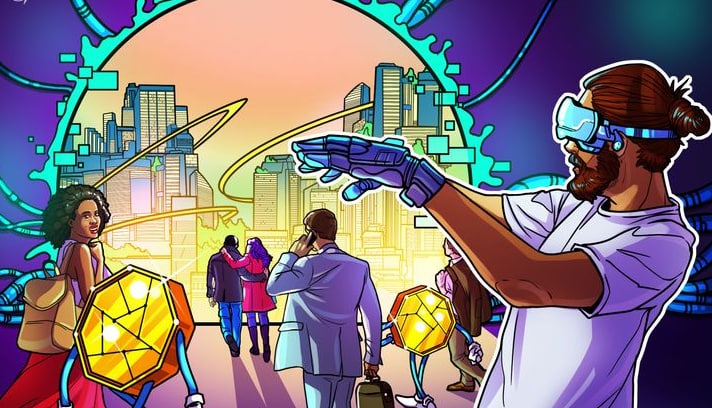
"Meta-universe as a service" will become the foundation of the Web3 Internet era
The concept of a meta-universe has been around since the 1980s, but it's only in recent years that we've seen hundreds of projects spring up in the field. What we're experiencing right now is a gamified world with limited integration and engagement. For now, the metaverse remains a blank canvas for early adopters to test the concept and have fun with. However, looking to the future of the meta-universe, which has the ability to bridge the divide between the physical and digital worlds, we need to keep pushing the concept of the meta-universe beyond itself. The leaders who are shaping the next generation of the Internet are poised to have a powerful impact on commerce, engagement, and entertainment.
The concept of a meta-universe has been around since the 1980s, but it's only in recent years that we've seen hundreds of projects spring up in the field. What we're experiencing right now is a gamified world with limited integration and engagement. For now, the metaverse remains a blank canvas for early adopters to test the concept and have fun with. However, looking to the future of the meta-universe, which has the ability to bridge the divide between the physical and digital worlds, we need to keep pushing the concept of the meta-universe beyond itself. The leaders who are shaping the next generation of the Internet are poised to have a powerful impact on commerce, engagement, and entertainment.
Each meta-universe has different needs
When it comes to the future of the meta-universe, whether it's a gamified world or a Web3 access point, everyone has their own idea. Users want the opportunity to define the space and shape it into a platform that reflects the most vivid imagination. A world where users can connect with their favorite music or visual artists will be very different from a world built to interact with sports fans. When web3 acts as a common thread across multiple metacomes, the idea is to use decentralization to ensure that each metacomes is a unique world that serves a different purpose. One size fits all is not the nature of the meta-universe, nor should it be. For MaaS, customization will be critical and in the hands of the creator. The esports meta-universe will rely more on team branding and gamified tokens, while artists may want to create an event space to host virtual concerts.
Each meta universe has different needs based on the level at which the industry and brand wants to engage with the end user. The meta universe is where brands grow their fan base and build community. Therefore, not only will the elements be different, but the brand positioning of the entire metaverse will also be very different. As more and more brands choose to extend their interactive communities into the metacomes, the metacomes need to be more customizable.
Not everyone has the ability to build this type of meta-universe - just like not everyone can learn to write code to build a website, but then platforms like WordPress and Shopify came along. These platforms provide a core foundation built by technologists and industry experts, while allowing end-users to customize according to brand and strategy. This is the benefit of metacomunion-as-a-Service (MaaS).
Build with interoperability in mind
A virtual environment is a place to socialize, build relationships, and create communities where people can interact with other users in real time. Taking it a step further, users should not be locked into one meta-universe or community, but must be able to interact with other meta-universes and teleport their avatars between them. Imagine if you had to change your browser every time you visited a website, depending on where it was built or hosted. Then you don't want to. Interoperability ensures that any built metacomes will not become a virtual island, and users across multiple metacomes will be able to exchange experiences and property. Therefore, every element must be designed around interoperability, and every Web3-enabled solution needs to function properly in every meta-universe - whether it's a token, an avatar, an NFT, or other digital asset.
Built with interoperability in mind, it will connect users, open borders, and make the meta-universe more accessible to all. Borderless solutions are already being used in other industries, but the same concepts must also be applied to the digital realm. For example, avatars in the esports meta-universe should be able to travel to the meta-universe of their favorite fashion brands to shop.
Enable users to build on top of the physical world
The meta-universe should not replace the real world, but should become an interactive layer that augments real-world experiences. MaaS also enables users to integrate layers of interaction within their own physical world. For example, if a person displays an NFT in their own house, a visitor can access that person's meta-universe by scanning a QR code, where the visitor can continue browsing the host's library of NFT - a feature that can be activated via XR. Without MaaS as an option, the meta-universe will continue to be a gamified world, with only the digital world existing as separate fault Spaces. MaaS will bridge the divide between the physical and digital worlds with immersive experiences and an always-on interactive layer.
As the metacomes continue to evolve, it's not just the blockchain experts behind them who will determine their appearance. MaaS will be a catalyst for creativity and a necessary path to economic prosperity for creators.
When the Internet came out in the 1980s, it would never have grown to what it is today without the people who started building on it. The early adopters will lay the groundwork for how the meta-universe will develop and what it will look like in the future. Mass adoption of the metacomes will only be possible if MaaS allows non-crypto native users to start creating their own metacomes, paving the way for the next generation of digital ecosystems.